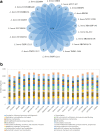Comparative genome analysis of the Lactobacillus brevis species
- PMID: 31122208
- PMCID: PMC6533708
- DOI: 10.1186/s12864-019-5783-1
Comparative genome analysis of the Lactobacillus brevis species
Abstract
Background: Lactobacillus brevis is a member of the lactic acid bacteria (LAB), and strains of L. brevis have been isolated from silage, as well as from fermented cabbage and other fermented foods. However, this bacterium is also commonly associated with bacterial spoilage of beer.
Results: In the current study, complete genome sequences of six isolated L. brevis strains were determined. Five of these L. brevis strains were isolated from beer (three isolates) or the brewing environment (two isolates), and were characterized as beer-spoilers or non-beer spoilers, respectively, while the sixth isolate had previously been isolated from silage. The genomic features of 19 L. brevis strains, encompassing the six L. brevis strains described in this study and thirteen L. brevis strains for which complete genome sequences were available in public databases, were analyzed with particular attention to evolutionary aspects and adaptation to beer.
Conclusions: Comparative genomic analysis highlighted evolution of the taxon allowing niche colonization, notably adaptation to the beer environment, with approximately 50 chromosomal genes acquired by L. brevis beer-spoiler strains representing approximately 2% of their total chromosomal genetic content. These genes primarily encode proteins that are putatively involved in oxidation-reduction reactions, transcription regulation or membrane transport, functions that may be crucial to survive the harsh conditions associated with beer. The study emphasized the role of plasmids in beer spoilage with a number of unique genes identified among L. brevis beer-spoiler strains.
Keywords: Beer adaptation; Beer spoilage; Genomics; Lactobacillus brevis; Pan-genome; SMRT sequencing.
Conflict of interest statement
The authors declare that TOS and JG are employees of Heineken and supplied
Figures





Similar articles
-
Comparative genomic and plasmid analysis of beer-spoiling and non-beer-spoiling Lactobacillus brevis isolates.Can J Microbiol. 2017 Dec;63(12):970-983. doi: 10.1139/cjm-2017-0405. Epub 2017 Oct 4. Can J Microbiol. 2017. PMID: 28977764
-
Comparative Genomics of Lactobacillus brevis Reveals a Significant Plasmidome Overlap of Brewery and Insect Isolates.Curr Microbiol. 2019 Jan;76(1):37-47. doi: 10.1007/s00284-018-1581-2. Epub 2018 Oct 19. Curr Microbiol. 2019. PMID: 30341451
-
Identification of ecotype-specific marker genes for categorization of beer-spoiling Lactobacillus brevis.Food Microbiol. 2015 Oct;51:130-8. doi: 10.1016/j.fm.2015.05.015. Epub 2015 May 29. Food Microbiol. 2015. PMID: 26187837
-
A Plasmid-Encoded Putative Glycosyltransferase Is Involved in Hop Tolerance and Beer Spoilage in Lactobacillus brevis.Appl Environ Microbiol. 2020 Jan 21;86(3):e02268-19. doi: 10.1128/AEM.02268-19. Print 2020 Jan 21. Appl Environ Microbiol. 2020. PMID: 31757821 Free PMC article.
-
Beer spoilage bacteria and hop resistance.Int J Food Microbiol. 2003 Dec 31;89(2-3):105-24. doi: 10.1016/s0168-1605(03)00153-3. Int J Food Microbiol. 2003. PMID: 14623377 Review.
Cited by
-
Genome Mining Approach Reveals the Occurrence and Diversity Pattern of Clustered Regularly Interspaced Short Palindromic Repeats/CRISPR-Associated Systems in Lactobacillus brevis Strains.Front Microbiol. 2022 Jun 3;13:911706. doi: 10.3389/fmicb.2022.911706. eCollection 2022. Front Microbiol. 2022. PMID: 35722276 Free PMC article.
-
Levilactobacillus brevis, autochthonous to cucumber fermentation, is unable to utilize citric acid and encodes for a putative 1,2-propanediol utilization microcompartment.Front Microbiol. 2023 Jul 26;14:1210190. doi: 10.3389/fmicb.2023.1210190. eCollection 2023. Front Microbiol. 2023. PMID: 37564281 Free PMC article.
-
Potential Health Benefits of Fermented Vegetables with Additions of Lacticaseibacillus rhamnosus GG and Polyphenol Vitexin Based on Their Antioxidant Properties and Prohealth Profiles.Foods. 2024 Mar 22;13(7):982. doi: 10.3390/foods13070982. Foods. 2024. PMID: 38611288 Free PMC article.
-
Surface Layer Protein Pattern of Levilactobacillus brevis Strains Investigated by Proteomics.Nutrients. 2022 Sep 6;14(18):3679. doi: 10.3390/nu14183679. Nutrients. 2022. PMID: 36145058 Free PMC article.
-
Complete Genome Sequencing and Comparative Genome Characterization of Lactobacillus johnsonii ZLJ010, a Potential Probiotic With Health-Promoting Properties.Front Genet. 2019 Sep 10;10:812. doi: 10.3389/fgene.2019.00812. eCollection 2019. Front Genet. 2019. PMID: 31552103 Free PMC article.
References
-
- Vos, P., G. Garrity, D. Jones, N.R. Krieg, W. Ludwig, F.A. Rainey, K.-H. Schleifer, and W. Whitman, Bergey's manual of systematic bacteriology: volume 3: the Firmicutes. 2011. 3: p. 464–511.
-
- Felis GE, Dellaglio F. Taxonomy of lactobacilli and Bifidobacteria. Current issues in intestinal microbiology. 2007;8(2):44–61. - PubMed
-
- Makarova K, Slesarev A, Wolf Y, Sorokin A, Mirkin B, Koonin E, Pavlov A, Pavlova N, Karamychev V, Polouchine N, Shakhova V, Grigoriev I, Lou Y, Rohksar D, Lucas S, Huang K, Goodstein DM, Hawkins T, Plengvidhya V, Welker D, Hughes J, Goh Y, Benson A, Baldwin K, Lee J, Díaz-Muñiz I, Dosti B, Smeianov V, Wechter W, Barabote R, Lorca G, Altermann E, Barrangou R, Ganesan B, Xie Y, Rawsthorne H, Tamir D, Parker C, Breidt F, Broadbent J, Hutkins R, O'Sullivan D, Steele J, Unlu G, Saier M, Klaenhammer T, Richardson P, Kozyavkin S, Weimer B, Mills D. Comparative genomics of the lactic acid bacteria. Proc Natl Acad Sci U S A. 2006;103(42):15611–15616. doi: 10.1073/pnas.0607117103. - DOI - PMC - PubMed
MeSH terms
Grants and funding
LinkOut - more resources
Full Text Sources
Molecular Biology Databases
Miscellaneous

